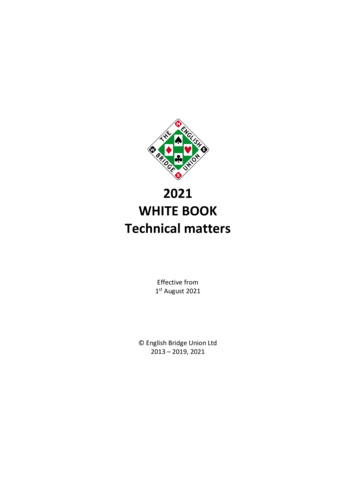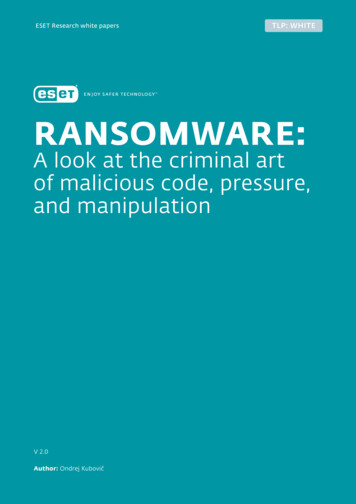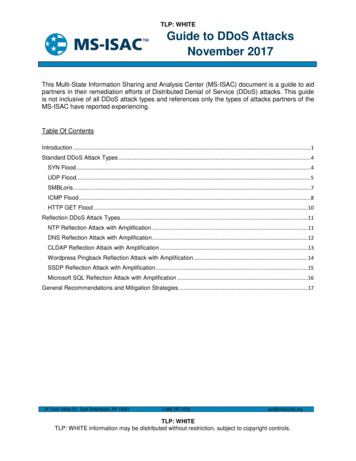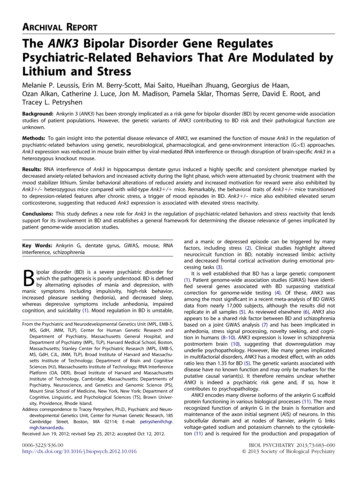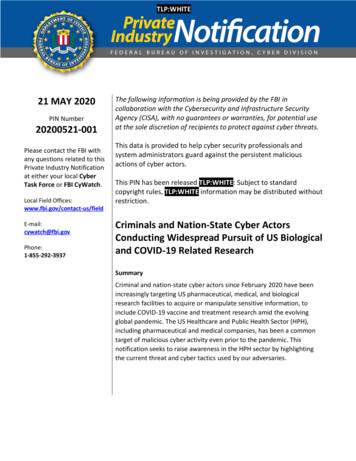
Transcription
TLP:WHITE21 MAY 2020PIN Number20200521-001Please contact the FBI withany questions related to thisPrivate Industry Notificationat either your local CyberTask Force or FBI CyWatch.Local Field @fbi.govPhone:1-855-292-3937The following information is being provided by the FBI incollaboration with the Cybersecurity and Infrastructure SecurityAgency (CISA), with no guarantees or warranties, for potential useat the sole discretion of recipients to protect against cyber threats.This data is provided to help cyber security professionals andsystem administrators guard against the persistent maliciousactions of cyber actors.This PIN has been released TLP:WHITE: Subject to standardcopyright rules, TLP:WHITE information may be distributed withoutrestriction.Criminals and Nation-State Cyber ActorsConducting Widespread Pursuit of US Biologicaland COVID-19 Related ResearchSummaryCriminal and nation-state cyber actors since February 2020 have beenincreasingly targeting US pharmaceutical, medical, and biologicalresearch facilities to acquire or manipulate sensitive information, toinclude COVID-19 vaccine and treatment research amid the evolvingglobal pandemic. The US Healthcare and Public Health Sector (HPH),including pharmaceutical and medical companies, has been a commontarget of malicious cyber activity even prior to the pandemic. Thisnotification seeks to raise awareness in the HPH sector by highlightingthe current threat and cyber tactics used by our adversaries.
TLP:WHITEThreatCyber-enabled criminal and state actors continue to target US clinical trials data, personallyidentifiable information (PII), personal health information (PHI), trade secrets, means ofproducing critical HPH goods, and sensitive data and proprietary research of US universities andresearch facilities. Likely due to the current global public health crisis, the FBI has observedsome nation-states shifting cyber resources to collect against the HPH sector, while criminalsare targeting similar entities for financial gain. The FBI has observed malicious actorssuccessfully compromising US victim networks through social engineering, hacking emails, andexploiting common vulnerabilities of connected devices and Internet of Things (IoT) equipmentused in laboratories.The scale and urgency of the COVID-19 health crisis exacerbates the threat against the HPHsector in two ways: As entities are focused on meeting urgent demands for research and productdevelopment, potential neglect of critical cyber security practices may compoundexisting known vulnerabilities.Nation-state cyber actors are targeting COVID-19-related research as many foreigngovernments seek to accelerate their own R&D processes and clinical trials. Thecompromise of US research and sensitive data undermines the effectiveness of USpharmaceutical, medical, and biological companies and harms US response efforts forhealth crises, including the pandemic.Adversaries are targeting a wide range of US-based entities with access to research usingnetwork intrusions, including: academic institutions;biological facilities;bioscience industries;medical facilities;medical device manufacturers;pharmaceutical facilities;scientific collaborations; anduniversity laboratories.The following examples illustrate targeting of the HPH sector observed by the FBI sinceFebruary 2020.
TLP:WHITE An identified healthcare-related company notified the FBI of suspected AdvancedPersistent Threat (APT) activity on its network. The threat actors leveraged a Confluenceserver vulnerability to install a backdoor on a Windows server, which was identified bythe beacon activity to a Command and Control (C2) IP address. The threat actor thenleveraged a valid domain administrator account to move laterally within the network.After containment, threat actors were observed trying to unsuccessfully regain accessvia the same initial critical vulnerability. An identified US university reported an attempted intrusion into its computer network.The university received thousands of authentication requests against its hybridexchange servers. The attackers unsuccessfully attempted to use previously acquiredaccount credentials, likely acquired in a previous known breach. Likely nation-state cyber actors conducted a multi-month campaign targeting multipleexternal-facing devices (primarily Juniper VPN endpoints and Citrix devices) of anidentified US research entity. The actors used legitimate credentials and VPN controls.When defensive measures were taken, the actors made extensive attempts to regainaccess to the network. The actors predominately conducted their activity through theevening and early morning US time. A biological research facility experienced a ransomware attack that encrypted its data.The facility was able to restore most of the encrypted data with backups and paperrecords.The following examples illustrate targeting of the HPH sector prior to this year. In mid-2019, an unidentified actor used social engineering to impersonate an employeeto gain access to an identified university’s Biosafety Level (BSL) 3 facility. The actorattempted to reset passwords and phone numbers of the victim employee to bypasstwo-factor identification. The actor successfully gained access to the victim employee’saccount before the university changed the password. In early 2019, a US-based DNA sequence company’s email account was hacked byunidentified actors. The actors impersonated company employees and sent emails toindividuals associated with the company and requested money transfers.
TLP:WHITE In early 2019, an unidentified actor gained unauthorized access to a pharmacy’snetwork and successfully escalated their network privileges; however, they wereunsuccessful in attempts to access medical records and PII. In late 2018, a separate US BSL-3 laboratory reported an unidentified actor attemptedto gain access to its networks by hacking a laboratory printer.Cyber Actors and ActivityCriminal and nation-state cyber actors routinely leverage open source information, such associal media postings, press releases, and official publications, to identify targets of interest.After gaining access, usually through an unpatched vulnerability or previously acquiredlegitimate credentials, the actors target information on a company’s internal network,networked equipment, shared drives, and email servers, as well as information availablethrough managed service providers or cloud providers. Some actors exfiltrate information topass to foreign governments or foreign competitors. Others may seek to modify or delete dataon a network or to encrypt the data with ransomware, making it unavailable to the owners.Specific to COVID-19 related research, data manipulation and deletion attempts couldundermine the credibility and integrity of ongoing research efforts and the results of clinicaltrials, delaying the delivery of a potential vaccine and treatment. Information sought by theactors could include, but is not necessarily limited to: research proposals, development, and production plans of new vaccines, drugs, andrelated technology;drafts of research grant or contract submissions, including manuscripts for publication;virus testing kits/equipment and related technology;clinical trial information and results;drugs with expiring international patents;cancer-related treatments/drugs; marketing information; andfinancial information, including manufacturing/production and retail costs.The FBI observed cyber actors using tactics to include but not limited to: Exploitation of unpatched vulnerabilities on web-facing servers to gain access tosystems;
TLP:WHITE Installation of web shells on a compromised network and/or obtaining legitimatecredentials to log onto a system;Reconnaissance of companies’ networks and identification of remote access systems;actors could exploit unpatched vulnerabilities to gain access and/or log on withlegitimate credentials;Exploitation of third-party connections, such as managed services providers, to gainaccess to a network;Sending of spear-phishing messages to employees with malicious links and/or malware;and,Targeting employee or family member emails and telework applications to compromisehome networks.Recommendations Assume press attention affiliating your organization with COVID-19 research will lead toincreased interest and activity by nation-state and cyber criminal actors to penetrateyour network.Patch critical vulnerabilities on all systems. Prioritize patching of Internet-connectedservers for known vulnerabilities as well as software that processes Internet data, suchas web browsers, browser plugins, and document readers. For additional guidance onidentifying and patching the most commonly exploited vulnerabilities, refer to Alert(AA20-133A): Top 10 Routinely Exploited Vulnerabilities published by the FBI and CISAon 12 May 2020. [Reference link: vely scan and monitor web applications for unauthorized access, modification, andanomalous activities.Strengthen credential requirements and implement multi-factor authentication toprotect individual accounts. Change passwords and do not use the same passwords formultiple accounts.Identify and suspend access of users exhibiting unusual activity.Network device management interfaces such as Telnet, SSH, Winbox, and HTTP shouldbe turned off for wide-area network (WAN) interfaces and secured with strongpasswords and encryption, when enabled.When possible, segment critical information on air-gapped systems. Use strict accesscontrol measures for critical data.Be mindful of new and existing cyber infrastructure for work and biosciencecollaborations.
TLP:WHITEReporting NoticeThe FBI encourages recipients of this document to report information concerning suspicious orcriminal activity to their local FBI field office, the FBI’s 24/7 Cyber Watch (CyWatch), the FBI’sInfraGuard, or local field office WMD Coordinator. Field office contacts can be identified atwww.fbi.gov/contact-us/field. CyWatch can be contacted by phone at (855) 292-3937 or byemail at CyWatch@fbi.gov.When available, each report submitted should include the date, time, location, type of activity,number of people, and type of equipment used for the activity, the name of the submittingcompany or organization, and a designated point of contact. Press inquiries should be directedto the FBI’s National Press Office at npo@fbi.gov or (202) 324-3691.Administrative NoteThis product is marked TLP:WHITE. Subject to standard copyright rules, TLP:WHITE informationmay be distributed without restriction.For comments or questions related to the content or dissemination of this product, contactCyWatch.Your Feedback Regarding this Product is CriticalPlease take a few minutes to send us your feedback. Your feedbacksubmission may be anonymous. We read each submission carefully, and yourfeedback will be extremely valuable to the FBI. Feedback should be specific toyour experience with our written products to enable the FBI to make quickand continuous improvements to these products. Feedback may besubmitted online here: https://www.ic3.gov/PIFSurvey
external-facing devices (primarily Juniper VPN endpoints and Citrix devices) of an identified US research entity. The actors used legitimate credentials and VPN controls. When defensive measures were taken, the actors made extensive attempts to regain access to the network. The actors predominately conducted their activity through the


